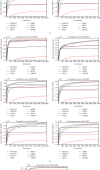Differential Human Learning Optimization Algorithm
- PMID: 35535198
- PMCID: PMC9078769
- DOI: 10.1155/2022/5699472
Differential Human Learning Optimization Algorithm
Abstract
Human Learning Optimization (HLO) is an efficient metaheuristic algorithm in which three learning operators, i.e., the random learning operator, the individual learning operator, and the social learning operator, are developed to search for optima by mimicking the learning behaviors of humans. In fact, people not only learn from global optimization but also learn from the best solution of other individuals in the real life, and the operators of Differential Evolution are updated based on the optima of other individuals. Inspired by these facts, this paper proposes two novel differential human learning optimization algorithms (DEHLOs), into which the Differential Evolution strategy is introduced to enhance the optimization ability of the algorithm. And the two optimization algorithms, based on improving the HLO from individual and population, are named DEHLO1 and DEHLO2, respectively. The multidimensional knapsack problems are adopted as benchmark problems to validate the performance of DEHLOs, and the results are compared with the standard HLO and Modified Binary Differential Evolution (MBDE) as well as other state-of-the-art metaheuristics. The experimental results demonstrate that the developed DEHLOs significantly outperform other algorithms and the DEHLO2 achieves the best overall performance on various problems.
Copyright © 2022 Pinggai Zhang et al.
Conflict of interest statement
The authors declare that they have no conflicts of interest.
Figures
Similar articles
-
Liver Cancer Algorithm: A novel bio-inspired optimizer.Comput Biol Med. 2023 Oct;165:107389. doi: 10.1016/j.compbiomed.2023.107389. Epub 2023 Aug 30. Comput Biol Med. 2023. PMID: 37678138
-
MHO: A Modified Hippopotamus Optimization Algorithm for Global Optimization and Engineering Design Problems.Biomimetics (Basel). 2025 Feb 5;10(2):90. doi: 10.3390/biomimetics10020090. Biomimetics (Basel). 2025. PMID: 39997113 Free PMC article.
-
A Novel Artificial Electric Field Algorithm for Solving Global Optimization and Real-World Engineering Problems.Biomimetics (Basel). 2024 Mar 19;9(3):186. doi: 10.3390/biomimetics9030186. Biomimetics (Basel). 2024. PMID: 38534871 Free PMC article.
-
Mixture Optimization of Cementitious Materials Using Machine Learning and Metaheuristic Algorithms: State of the Art and Future Prospects.Materials (Basel). 2022 Nov 6;15(21):7830. doi: 10.3390/ma15217830. Materials (Basel). 2022. PMID: 36363421 Free PMC article. Review.
-
Machine Learning and Metaheuristics Approach for Individual Credit Risk Assessment: A Systematic Literature Review.Biomimetics (Basel). 2025 May 17;10(5):326. doi: 10.3390/biomimetics10050326. Biomimetics (Basel). 2025. PMID: 40422156 Free PMC article. Review.
Cited by
-
A comparative evaluation of nature-inspired algorithms for feature selection problems.Heliyon. 2023 Dec 12;10(1):e23571. doi: 10.1016/j.heliyon.2023.e23571. eCollection 2024 Jan 15. Heliyon. 2023. PMID: 38187288 Free PMC article.
-
An improved hippopotamus optimization algorithm based on adaptive development and solution diversity enhancement.PeerJ Comput Sci. 2025 May 29;11:e2901. doi: 10.7717/peerj-cs.2901. eCollection 2025. PeerJ Comput Sci. 2025. PMID: 40567800 Free PMC article.
References
-
- Elsawy M. M. R., Lanteri S., Duvigneau R., Fan J. A., Genevet P. Numerical optimization methods for Metasurfaces. Laser & Photonics Reviews . 2020;14(10) doi: 10.1002/lpor.201900445.1900445 - DOI
-
- Dokeroglu T., Sevinc E., Kucukyilmaz T., Cosar A. A survey on new generation metaheuristic algorithms. Computers & Industrial Engineering . 2019;137 doi: 10.1016/j.cie.2019.106040.106040 - DOI
-
- Hansen P., Mladenović N., Moreno Pérez J. A. Variable neighbourhood search: methods and applications. Annals of Operations Research . 2010;175(1):367–407. doi: 10.1007/s10479-009-0657-6. - DOI
-
- Holland J. H. Genetic algorithms. Scientific American . 1992;267(1):66–72. doi: 10.1038/scientificamerican0792-66. - DOI
-
- Kennedy J., Eberhart R. Particle swarm optimization. Proceedings of the ICNN’95-international conference on neural networks; August 1995; Perth, Australia. IEEE; pp. 1942–1948.
MeSH terms
LinkOut - more resources
Full Text Sources





